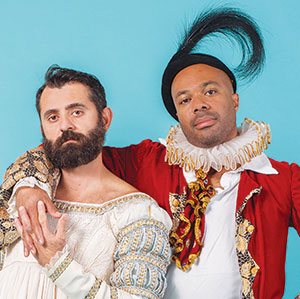Arts
'Sense of Self' at SJICA
 ON BACKGROUND: Jamil Hellu's photography is part of the 'Sense of Self' exhibit at the San Jose Institute of Contemporary Art.
ON BACKGROUND: Jamil Hellu's photography is part of the 'Sense of Self' exhibit at the San Jose Institute of Contemporary Art.
None of the bare-chested black men in Erica Deeman's photo series "Brown" smile or look into your eyes. They avert their gaze from the photographer, the camera lens and the unseen viewer in the gallery.
Deeman crops each square image just below the shoulders, mid-torso. There's a purposeful uniformity to the images, only five of which have been culled from the entire series. She places each subject against a mocha-colored backdrop, one that she's chosen to match her own mixed-racial skin tone. In an interview for her 2017 show at the Anthony Meier Fine Arts gallery in San Francisco, Deeman said she's exploring "the spectrum of brownness."
The photographs are also intentional inversions of black and white mug shots, intent on decriminalizing the pose. She humanizes that bureaucratic headshot with color, while at the same time rejecting the pseudo-science of physiognomy.
A contemporary of Deeman's, Jordan Casteel, is also making a major contribution to the revival of portraiture. In one series for "Returning the Gaze" at the Cantor Arts Center, Casteel paints several black men. Her naked subjects look directly at her and at us. The viewer gets to know them, or we can extrapolate something about their lives from the expressions on their faces and from the vibrant interiors she places around them. Both artists want to fill museum walls with black and brown bodies that have been mis- or underrepresented.
Deeman's work is part of the San Jose Institute of Contemporary Art's "Sense of Self" (through March 15, 2020), a photography survey that also manages to forefront images from the LGBTQ community. Tammy Rae Carland's series, "Lesbian Beds," looks slightly off-topic when compared with her black and white self-portraits in "On Becoming." Like Cindy Sherman, Carland assumes another identity. Actually, two. She's re-created old family snapshots of her mother and father by playing both of them. Unlike Sherman, her series is a form of autobiography that's based on the factual evidence of their marriage. These images stand on their own as a complete thought—we are, in an essential sense, our parents—but I wanted to see the original photographs, too, to see how her versions resonate with or against them, to see the resemblance.
Without the title to corral them, it's hard to say that the tangled sheets and mess of pillows are strictly beds that have been slept in by lesbians. They're portraits in absentia, with arrangements of colorful visual clues, like a black cat or a cushion with a carefully composed opening.
On the opposite end of that spectrum is Jamil Hellu, who teaches photography in the Department of Art and Art History at Stanford. He's all about being present, a companionable collaborator with his subjects. In his portrait of Joe Elwin, Hellu and Elwin stand side by side dressed in what must be 17th-century Shakespearean costumes. The explanatory note, which doesn't explain the choice of couture, reads, "Joe Elwin's mother is African-American and French. He describes his father as a Caribbean mutt."
Hellu's approach is cheeky. His visual wit makes more sense when he gives us a little more information about another subject: "Corey Christopher's family expected him to join the US Armed Forces...but homosexuals were not allowed to serve in the military in those days." Dressed in a black sailor suit and a white cap, Hellu holds Christopher in his arms. There's a cigarette dangling out of Hellu's mouth and an orange life preserver hanging around Christopher's neck. Christopher looks at the camera, aghast and delighted, as Hellu carries him away. In every one of his photographs, Hellu erases the line between artist and subject, making the gleeful case that it should never have existed in the first place.
Marcela Pardo Ariza presents her S&M devotees more anonymously in "Kin Skin." We see plenty of skin but no faces. They're serious about their straps, snaps and buckles. But all that black leather paraphernalia has been enlarged and printed out on wallpaper behind her images. It adds an unnecessary exclamation point in the same way that the walls around Deeman's work have been painted brown. That extra emphasis is unnecessary for artists who are already confident and in charge of their art. The gallery walls don't need to repeat what the photographers have already said.
Sense of Self
Thru March 15, 2020, Free
San Jose Institute of Contemporary Art
sjica.org


